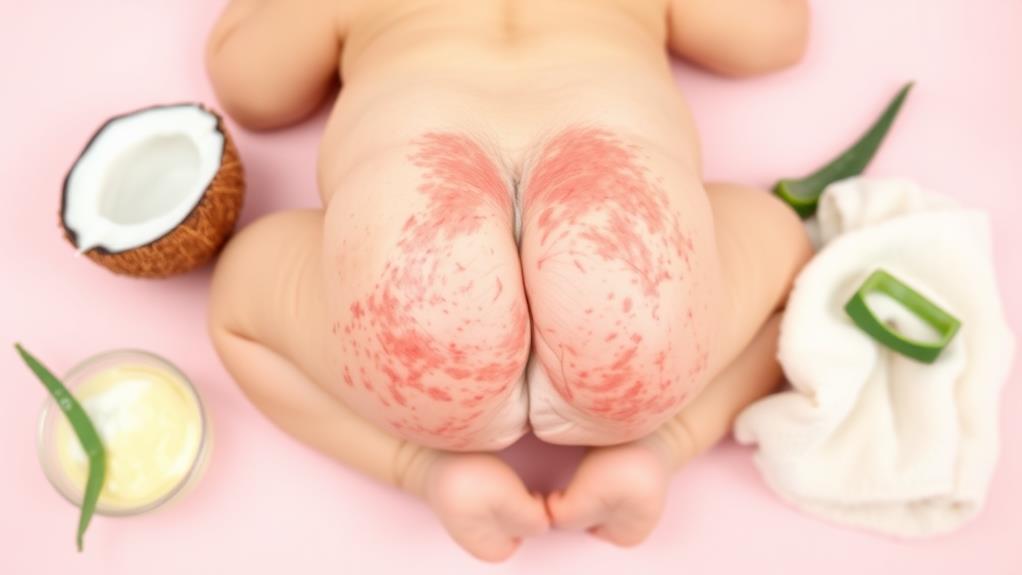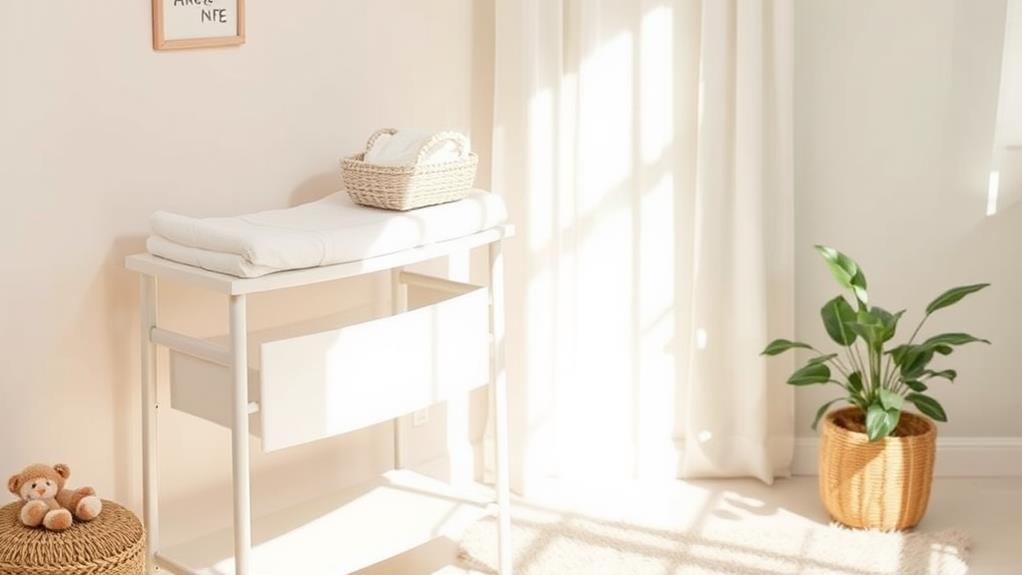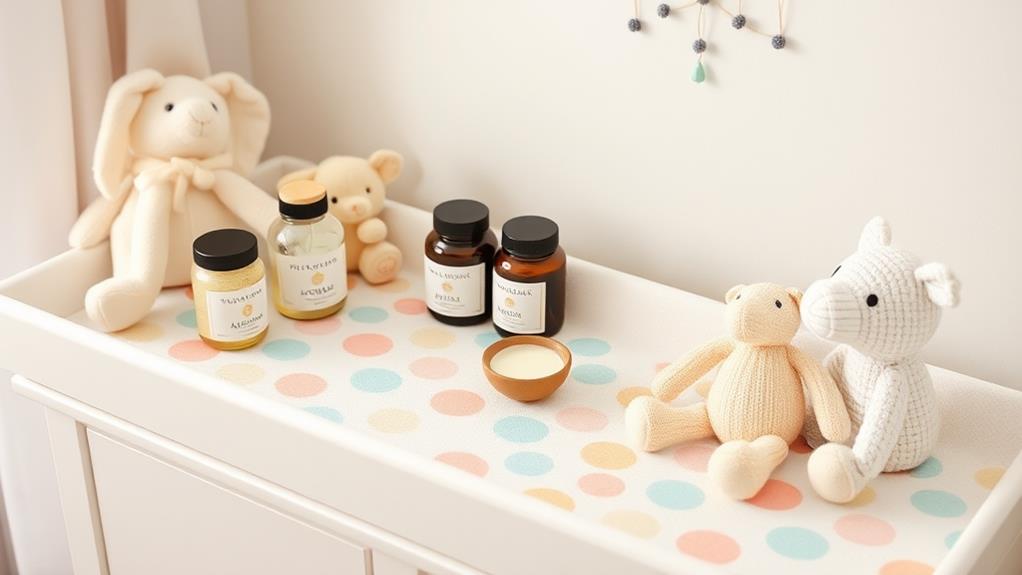When your little one develops a yeast diaper rash, it can be frustrating and concerning. You'll want to act quickly to relieve discomfort and promote healing. Keeping the area clean and dry is crucial, but there are also effective home remedies you might not have considered. From natural antifungal properties found in coconut oil to the soothing effects of oatmeal baths, these strategies can make a significant difference. Curious about which remedies work best and when to seek professional help? Let's explore the essential steps and tips that can help you manage the situation effectively.
Understanding Yeast Diaper Rash

Understanding yeast diaper rash is essential for parents and caregivers who want to keep their little ones comfortable. This common condition occurs when a fungus called Candida overgrows in the warm, moist environment of a diaper. Yeast thrives in these conditions, especially if your baby has been on antibiotics or has a weakened immune system.
You might notice the rash appearing as red, inflamed patches, often surrounded by little red bumps. It can make your baby feel irritable and uncomfortable, which is tough for both of you.
The key is to recognize that yeast diaper rash is different from regular diaper rash. While standard diaper rash may develop from irritation, yeast diaper rash usually requires a specific treatment approach.
Keeping your baby's skin dry and clean is crucial in preventing yeast growth. Frequent diaper changes, using breathable diapers, and allowing some diaper-free time can help.
It's important to remember that if you suspect your little one has a yeast diaper rash, consulting a healthcare professional can provide guidance and reassurance.
Understanding the basics of this condition empowers you to take the right steps for your child's comfort and health.
Identifying Symptoms
Yeast diaper rash can be identified by distinct symptoms that set it apart from other types of rashes. One of the most noticeable signs is the bright red, inflamed skin in the diaper area. You might also see raised, red bumps or pustules that form around the edges of the rash, which can look like little dots or blisters.
Unlike other rashes, yeast diaper rash often has well-defined borders, making it easier to spot. Additionally, your baby may show signs of discomfort, such as fussiness or crying when you change their diaper. If you notice a strong, yeasty smell, it could also indicate a yeast infection.
Sometimes, the rash can spread to the folds of the skin, such as the thighs and buttocks, which can make it more challenging to treat. Keep an eye on how long the rash lasts. If it doesn't improve after a couple of days with standard diaper rash treatments, it may be time to consider that it's a yeast infection.
Recognizing these symptoms early can help you provide the right care and comfort for your little one.
Causes of Yeast Diaper Rash

Several factors can contribute to the development of a yeast diaper rash. First, moisture plays a significant role. When your baby's diaper area stays damp for long periods, it creates a perfect breeding ground for yeast.
This is especially true if your little one has been on antibiotics, which can disrupt the balance of bacteria and yeast in their body.
Diet can also be a factor. If your baby has recently started eating solid foods or if they're teething, their stool may change, which can irritate the skin and lead to a rash.
Additionally, if your baby is frequently in contact with urine or stool, it can further irritate the skin and promote yeast growth.
Certain skin conditions, such as eczema or previous diaper rashes, can make your baby more susceptible to yeast infections.
If you notice red, inflamed patches that appear in the folds of the skin, it's likely a yeast diaper rash.
Understanding these causes can help you take proactive steps to prevent and treat this uncomfortable condition, ensuring your baby stays happy and healthy.
Importance of Proper Hygiene
Maintaining proper hygiene is crucial in preventing and treating yeast diaper rash. When your baby's skin stays clean and dry, you're significantly reducing the chances of irritation and infection.
Regularly changing your baby's diaper is one of the simplest yet most effective ways to maintain hygiene. Aim to check the diaper every couple of hours and change it immediately if it's wet or soiled.
Be sure to gently clean the diaper area with warm water and a mild soap. Wiping with baby wipes can sometimes irritate sensitive skin, so it's best to use wipes specifically designed for delicate areas.
After cleaning, make sure to dry the area thoroughly, as moisture can lead to yeast growth. Additionally, letting your baby go diaper-free for short periods allows air to circulate and helps the skin stay dry.
It can be a little messy, but it's worth it for the health of your baby's skin. Lastly, remember to wash your hands before and after changing diapers.
Home Remedies to Try

If you're looking for effective home remedies to treat yeast diaper rash, there are a few simple options you can try.
First, consider using coconut oil. It has natural antifungal properties that can help combat yeast. Just apply a thin layer to the affected area after each diaper change.
Another remedy is plain yogurt. The live cultures in yogurt can help restore the natural balance of bacteria on your baby's skin. You can gently apply it to the rash and let it sit for about 20 minutes before rinsing it off.
Oatmeal baths are also great for soothing irritated skin. Simply add some colloidal oatmeal to warm bathwater, and let your baby soak for a while. This can relieve itching and discomfort.
Lastly, ensure your baby's bottom stays dry. You might let your baby go diaper-free for short periods to air out the affected area. Just remember to keep an eye out for messes!
These home remedies can help ease the discomfort of yeast diaper rash while promoting healing.
Always consult your pediatrician if the rash persists or worsens, as they can provide further guidance tailored to your child's needs.
Natural Remedies for Relief
Natural remedies can offer effective relief for yeast diaper rash, helping to soothe your baby's skin while promoting healing. One great option is coconut oil. Its antifungal properties can help fight the yeast causing the rash, while also moisturizing the skin. Simply apply a thin layer to the affected area after each diaper change.
Another helpful remedy is plain yogurt. The probiotics in yogurt can restore the skin's natural balance. Just dab a small amount onto the rash and let it sit for about 20 minutes before rinsing off gently with warm water.
In addition, you can try using a natural oatmeal bath. Oatmeal is known for its soothing effects on irritated skin. Add finely ground oatmeal to your baby's bathwater and let them soak for around 15 minutes to ease discomfort.
Lastly, consider airing out your baby's bottom. Allowing them to go diaper-free for a little while can help the affected area breathe and dry out, speeding up the healing process.
Over-the-Counter Treatments

When it comes to treating yeast diaper rash, over-the-counter treatments can provide quick relief and promote healing. You'll find several antifungal creams and ointments specifically designed to tackle yeast infections in the diaper area.
Look for active ingredients like clotrimazole or miconazole, which are effective at combating yeast overgrowth.
Before applying any product, make sure to clean and dry the affected area thoroughly. This step is crucial as moisture can worsen the rash.
Gently pat the skin dry, avoiding any rubbing that might irritate it further. Once the area is dry, apply a thin layer of the antifungal cream as directed on the packaging.
In addition to antifungal treatments, consider using barrier creams containing zinc oxide. These can protect the skin against moisture and friction, helping to prevent further irritation.
Always check the labels for age recommendations, as some products may not be suitable for infants.
When to Consult a Doctor
Recognizing when to consult a doctor is essential for effectively managing yeast diaper rash. If your little one's rash doesn't improve after a few days of home treatment, it's time to reach out to a healthcare professional. Persistent redness, swelling, or irritation can indicate that the rash is more serious than a basic yeast infection.
Additionally, if you notice any signs of infection, like oozing, blisters, or a fever, don't wait to get help. These symptoms could mean that bacteria have entered the skin and require medical attention.
Also, if your child seems unusually fussy or uncomfortable, it's worth checking in with your doctor.
Keep in mind that some babies might've recurring yeast infections. If you find yourself treating the same rash multiple times, consulting a doctor can provide insights into underlying causes or different treatment options.
Preventing Future Rashes

After addressing any immediate concerns with your child's yeast diaper rash, focusing on prevention can help keep future rashes at bay. One of the best ways to protect your little one is by maintaining a dry environment. Change diapers frequently, especially after they've soiled them, to reduce moisture.
When you do change diapers, gently clean the diaper area with mild soap and water—avoid harsh wipes that might irritate the skin. After cleaning, be sure to let the area dry completely before putting on a fresh diaper; air drying is ideal if you have the time.
You might also consider using a barrier cream, like petroleum jelly or zinc oxide, as a protective layer against moisture. Additionally, try to give your baby some diaper-free time each day to allow their skin to breathe.
Keep an eye on your child's diet, too, as certain foods can lead to yeast overgrowth. If you notice any signs of rashes, don't wait! Address them promptly to prevent them from worsening.
Tips for Diaper Care
For effective diaper care, it's crucial to choose the right products and establish a consistent routine. Start by selecting high-quality diapers that fit your baby well. A snug fit prevents leaks and keeps moisture away from their skin.
You'll also want to use a gentle, fragrance-free wipes or a soft cloth with warm water during diaper changes. This minimizes irritation and helps maintain the skin's natural barrier.
Change your baby's diaper frequently, ideally every 2-3 hours or as needed. The longer moisture stays against the skin, the greater the risk of rashes. During each change, take a moment to check for any signs of irritation or redness. If you spot anything concerning, act quickly to treat it.
After cleaning, allow your baby's skin to dry completely before putting on a fresh diaper. You can even let them go diaper-free for a little while to air out their skin.
Lastly, consider using a protective barrier cream that contains zinc oxide to further shield against moisture and friction. By following these tips, you'll help keep your baby's skin healthy and comfortable, reducing the risk of yeast diaper rash.




